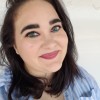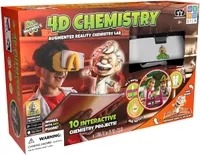Give the gift of Bill Nye with his virtual reality science kit

This year, you can give your kids the gift of science with fully immersive VR experiments from the scientist generations have grown up with — Bill Nye.
Bill Nye's Virtual Reality Science Kit ($59.99) includes VR goggles and a free mobile app that can be used on any smartphone to make kids feel like they're hanging out with Bill in his lab or are exploring rocky caves, volcanoes, or waterfalls.
Bill Nye (the Science Guy)'s kit includes an 80-page book that can be brought to life through the VR goggles, which teaches 30 step-by-step science projects.
Kids will learn chemistry, biology, and physics through experiments that help them "tattoo" an egg, create a lemon battery, or make their own speakers. They'll learn about scientific principles like density, oxidation, and chemical reactions and be able to follow along with Bill Nye as he walks them through all 30 experiments (with all the materials they'll need included in the 50 piece set).
In addition to the hands-on experiments, kids will get to watch 185 VR and AR experiences, not only in Bill Nye's lab but also in volcanoes, waterfalls, icy rocks, and caves.
If you’re looking for a VR gift specific for space lovers, we also recommend Professor Maxwell's VR Universe ($49.99). Like the Bill Nye kit, this VR science kit also includes hands-on experiments and play. The 21 piece set includes materials kids will need for 31 projects, including space-related games, experiments, and crafts like creating moon dough and building a compass to explore magnetic fields and a sun dial to learn about the sun's rotation.
The VR goggles in Professor Maxwell's kit bring pictures from the 80-page activity book to life, letting kids get a 360-degree view of the sun, for example. The goggles also allow kids to feel as if they're astronauts in space, exploring Earth, our solar system, our galaxy, and other parts of the universe. They'll get to drive a rover on Mars, see eclipses, and hold the Earth in their hands.
Bill Nye's VR Science Kit: $59.99 at Amazon
Bill Nye's virtual reality science kit immerses kids in Bill Nye's science lab and lets them explore rocky caves, waterfalls and other beautiful places as if they're there in person.
Professor Maxwell's VR Universe: $49.99 at Target
This virtual-reality science kit lets kids get fully immersed among the stars and planets. Includes hands-free goggles to create an immersive learning experience, as well as all the materials needed to build a sundial, magnetize a needle for a compass and even fire off your own rocket.
Professor Maxwell's 4D Augmented Reality Science Kit - Chemistry: $31.08 at Amazon
The kit comes with 10 immersive chemistry projects, each with step-by-step instructions with detailed illustrations that come alive in augmented reality. Kids can follow Professor Maxwell as he explains core scientific concepts and walks them through their experiments. Materials included: test tubes, beakers, magnifying glass and more.
Get the world’s most fascinating discoveries delivered straight to your inbox.

Kasandra Brabaw is a freelance science writer who covers space, health and psychology. She has a bachelor's degree in science and a bachelor's degree of arts from the University of Syracuse; she completed her master's of arts degree in journalism at Syracuse University in 2014. In addition to writing for Live Science and our sister site Space.com, Kasandra has written for Prevention, Women's Health, SELF and other health publications. She has also worked with academics to edit books written for popular audiences.





